7 /10 1 Votes
2.9/5 Abandonware DOS Composer(s) Paul Mogg Initial release date 1991 | 4.2/5 My Abandonware Designer(s) Larry Barbu Release date(s) NA: 1991EU: 1991 | |||||||||||||||||||||||||||||||||
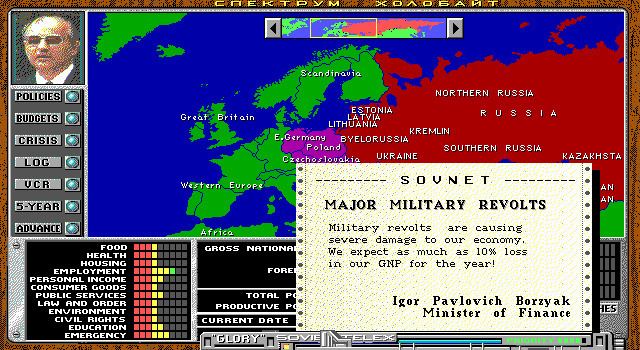 | ||||||||||||||||||||||||||||||||||
Similar MicroProse games, Government simulation games, Other games | ||||||||||||||||||||||||||||||||||
Crisis in the kremlin episode 1 hardline regime
Crisis in the Kremlin is a 1991 strategy video game with managerial aspects in which the player acts as General Secretary of the Communist Party of the Soviet Union from 1985 to 2017. The player assumes the role of the reformist Mikhail Gorbachev, the nationalist Boris Yeltsin, or the hardline Yegor Ligachev. Actual jokes recorded by the KGB can be found in the gameplay, depicting the concerns of the Soviet people in a humorous light. The game was developed and released at a time when the Soviet Union was collapsing and breaking apart with the game's events making reference to that. Indeed, the Soviet Union dissolved in the same year as the game's release.
Contents
- Crisis in the kremlin episode 1 hardline regime
- Let s play crisis in the kremlin part 1 2
- General gameplay
- Factions
- Criticism
- Reception
- Interesting facts
- References
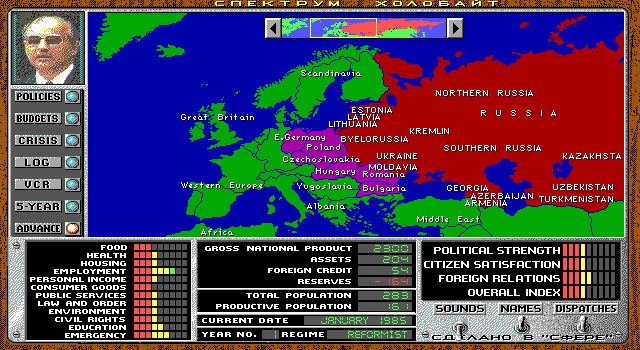
Let s play crisis in the kremlin part 1 2
General gameplay
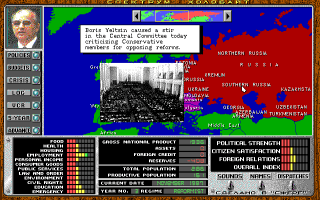
Starting in 1985, the player handles various governing tasks, from policies such as civil rights and the workweek to budgets. It was the first game to include the individual allocation of funding in a budget. A significant portion of the game involves special events, such as the 1988 Armenian earthquake or the Chernobyl disaster. The player's responses to these events can involve taking the historical route or a dramatically different approach; the player is given usually three to five choices after picking up the appropriate telephone. The player must walk a line between radicals, reformists, and hardliners. Overly scorning any side can cause the player to fall out of favor with it, which may lead to a vote of confidence in the Politburo. Warsaw Pact states will also begin to shy away from the Soviet Union, as will the Baltic states, the Ukraine, and other Union Republics.
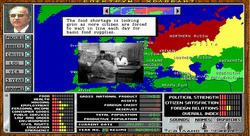
The player may cut or increase spending to various parts of the nation, such as construction, environment, the military, pensions, Soviet Republics, and so on. The player can spend toward different groups, such as bureaucrats or conservatives, to gain their support. A food shortage can occur, for example, if not enough money is being spent on agriculture and transport (roads, buses, railroads, trucks, highways, etc.).
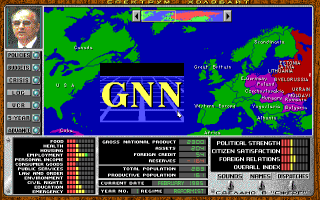
Extra events occur if the player lasts past the Soviet Union's (and the game's own) time frame, such as American intervention in North Korea or the ability to renegotiate a new Union treaty to form a confederation or disband the Soviet Union altogether in favor of a British-style commonwealth. New technology will also develop, as will fears of an asteroid hitting the earth. The new technology can include things like vaccines for AIDS (developed by Soviet scientists that will improve diplomatic relationships with other nations) and animal cloning solutions that will prevent world hunger - using in vitro meat.
Factions
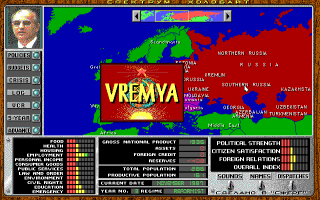
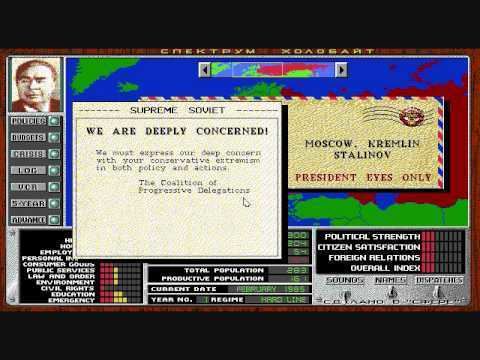
Criticism
Certain events repeat themselves each time the game is played: for example, the Chernobyl disaster. This lowers the replayability of the game, as a player can come to expect situations and plan accordingly. Some also view the collapse of the Soviet Union as an inevitable game result, as it is difficult to hold the country together past 1991, forcing the player to disband the USSR or face economic consequences that lead toward citizen revolt. One is doing well if any Republics remain in the Union by 2000. The player has the option to resign on January 1992, mimicking the move that Mikhail Gorbachev made. All the sounds made in the game are of very low MIDI-quality with a complete absence of a musical soundtrack.
Reception
Chuck Moss wrote in Computer Gaming World in 1992 that Crisis in the Kremlin was biased in a way that "drives the player toward establishing a free market, and both political and social liberation". The reviewer stated that as "an unreconstructed Reaganite" he agreed with the biases but noted that Cuba and China were examples of countries that did not perform USSR-like reforms and survived, writing that "This distorts the game's veracity from the outset". Moss criticized the detailed control the player has over the economy ("which was the USSR's problem in the first place!") without any way to reduce the control, and the lack of political conflicts with subordinates as in Hidden Agenda. Another example of the game's unrealism, the reviewer reported, was that he was repeatedly unable to have the USSR survive beyond 1988 when emulating Gorbachev. Moss nonetheless found the game very enjoyable ("I've played it for two months and I'm not sick of it") and approved of the graphics. He concluded that "This worthy stab at a limited genre is to be commended".
Interesting facts
The developers of post-Soviet countries was released a remake of this game under the same name "Crisis in the Kremlin : The collapse of the Empire ", but its functionality is different . [6] Unlike the original , it was possible to organize not only the preservation of the USSR and the Warsaw Pact , but also the expansion of the communist bloc countries such as Libya , South Africa , Venezuela , Iran, Iraq , Afghanistan , Yugoslavia and Albania . In this game, the opportunity to bring the United States to a state of civil war
Choosing rulers Gorbachev or Yeltsin , during the game the player will see their picture in the upper left corner , whereas Ligachev there will be a portrait of Brezhnev .
